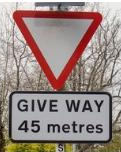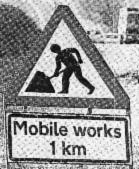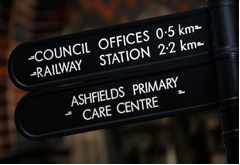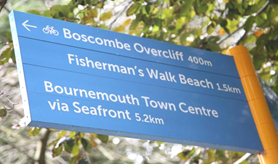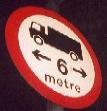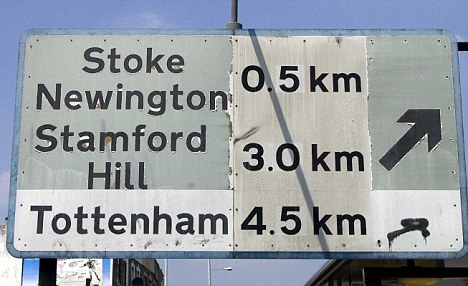
For many years, European Directive 80/181 stipulated that the mile and yard could only remain on British traffic signs “until a date to be fixed” by the British government. In 2010, the British government successfully negotiated the removal of this limitation, meaning that it is now for the UK alone to decide whether the mile should be replaced by the kilometre.
What is the British government’s position? The Department for Transport has stated (our emphasis):
“Both the present and previous governments have indicated that they have no plans to replace imperial signs with metric signs until the majority of drivers have been educated in the metric system, which is likely to be some time. It is for this reason that we would not consider changing the Regulations to allow the use of metric units on direction signs in the near future”.
This suggests that the government intends to consider metric road signs at some point. That it has not yet done so is probably because of the financial and political costs. The financial cost of changing two million signs will not diminish over time, and BWMA’s purpose is ensure that the political cost does not, either.
Distance signs
Road signs in Britain are governed by the Traffic Signs Regulations and General Directions 2016 (TSRGD). The present legal position is that metric units are not permitted on distance signs, whether by themselves or in conjunction with imperial units; distances must be in miles and yards, only. The following signs, for example, are unlawful:
Traffic Signs Regulations do not apply just to highways funded by the public purse, but to “any length of highway … to which the public has access” (Road Traffic Act 1984, section 142). Signs on private roads are therefore subject to the Traffic Signs Regulations, if used by the public, meaning restrictions on metric apply.
The Traffic Signs Regulations apply to all traffic signs, not just those for motorists; this includes signs for pedestrians, cyclists and equestrians, usually situated in town centres, around bus and train stations, and along sea fronts (TSRGD 2016, Schedule 12). The following distance signs are unlawful:
To reiterate, only yards and miles are authorised; metric distance units are not permitted, even if appearing alongside imperial units.
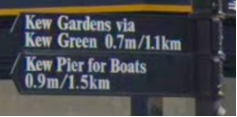
As can be seen from the above photographs, many local councils have been using metric unlawfully. These encroachments seem to occur because of an assumption that metric will be adopted eventually, and so local authorities breach the law in anticipation that the law will be changed.
The Department of Transport wrote to local authorities in April 2019, reminding them of the legal need to use imperial units on distance signs.
Height, width and length signs
Signs indicating height, width and length restrictions, typically seen on approaches to bridges and narrow roads, are also governed by the Traffic Signs Regulations. Here, the law requires both imperial and metric (aside from pre-2016 imperial-only signs, which can remain in place until replaced with a new sign).
Signs that display metric-only units for height, width and length restriction are therefore unlawful unless feet and inches are included, either on the same sign, or on a second sign in the immediate proximity. These metric signs are unlawful:
The following signs are lawful, because feet and inches appear with the metric:
What about signs at entrances to car parks? Regardless of whether the car park is private property, signs at the entrance are intended for motorists about to enter from the main road; therefore, the Traffic Signs Regulations apply. The following car park entrance sign is in breach of the legal requirement by failing to include feet and inches:
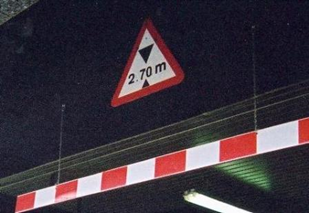
Taking action against unlawful metric signs
In recent years, hundreds of unlawful metric signs have been converted back to imperial, following letters of complaint by BWMA and its supporters. By enforcing the current law and removing illegal metric signs, a message can be sent to present and future governments that Britain will never accept kilometre “K-Day”.
Anyone can take action against unlawful metric signage.
1) The signs to identify are:
- All directional signs marked in metres or kilometres, regardless of whether metric is accompanied by yards or miles, and including those for pedestrians, etc. as well as motorists.
- Any height, width and length sign with metric indications, without corresponding imperial units.
2) Record the location of the sign and take a photograph. Survey the locality for further breaches of the law.
3) Write a letter of complaint to the local council (or, if the sign is on a motorway or trunk road, the Highways Agency). A letter may read like the following:
Dear Sir/Madam,
While travelling along [name of road or street] on [date], I saw a sign near the junction of [road], the giving the [distance/height/width] in [metres/metres-only]. I enclose a photograph of this sign.
As you may be aware, the 2016 Traffic Signs Regulations and General Directions require that [select as appropriate]:
· distances on signs for [motorists/pedestrians, etc.] must be described in yards and miles. Metric units are not permitted.
· Height/width/length restriction signs must include feet and inches. Metric-only height/ width/length restrictions are not permitted.
While I appreciate these signs may have been installed in error, they are unlawful. Please provide an indication when these signs will be replaced with lawful signs displaying imperial units. Please also give an assurance that any other metric signs within your authority will also be replaced.
I look forward to hearing from you.
Yours faithfully, etc.
Do not enter into discussions with local councils about arguments for and against metric signage. If a local authority believes that metre signs are beneficial, then it is up to them to have the law changed. Until then, it need only be explained that they must comply with the law.
4) Consider copying your letter to the local newspaper with a photograph of the metric sign, and start a debate in the letters column. The following points may be useful:
· The purpose of road signs is to communicate distance and speed to motorists and other users. We have such a system: yards, miles and mph. Metric conversion is not necessary.
· Miles, yards, feet and inches are part of the British scene; they should be preserved for this reason.
· There are an estimated two million signs in England that make reference to distance, height, width or speed. The costs of conversion would be huge.
· Metric signs are less accurate. Using metres to describe the height of bridges (e.g. 4.4m) achieves an accuracy of one tenth of a metre, or four inches. Signs in feet and inches are accurate to one inch.
· The vast majority of British people prefer miles and yards, not kilometres and metres.
